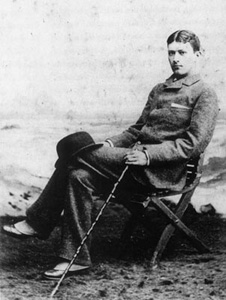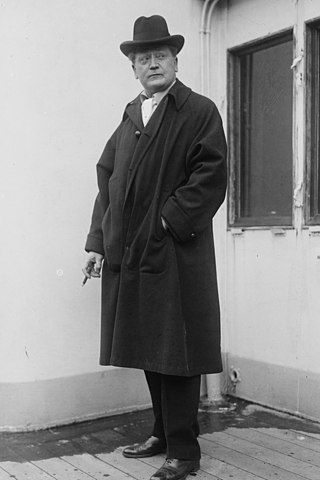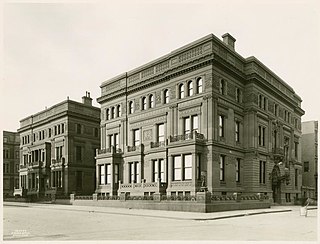The Vanderbilt family is an American family who gained prominence during the Gilded Age. Their success began with the shipping and railroad empires of Cornelius Vanderbilt, and the family expanded into various other areas of industry and philanthropy. Cornelius Vanderbilt's descendants went on to build grand mansions on Fifth Avenue in New York City; luxurious "summer cottages" in Newport, Rhode Island; the palatial Biltmore House in Asheville, North Carolina; and various other opulent homes. The family also built Berkshire cottages in the western region of Massachusetts; examples include Elm Court.

William Kissam Vanderbilt I was an American heir, businessman, philanthropist and horsebreeder. Born into the Vanderbilt family, he managed his family's railroad investments.

From the late 1870s to the 1920s, the Vanderbilt family employed some of the best Beaux-Arts architects and decorators in the United States to build an unequaled string of townhouses in New York City and palaces on the East Coast of the United States. Many of the Vanderbilt houses are now National Historic Landmarks. Some photographs of Vanderbilt residences in New York are included in the Photographic series of American Architecture by Albert Levy (1870s).

Richard Morris Hunt was an American architect of the nineteenth century and an eminent figure in the history of architecture of the United States. He helped shape New York City with his designs for the 1902 entrance façade and Great Hall of the Metropolitan Museum of Art's Fifth Avenue building, the pedestal of the Statue of Liberty, and many Fifth Avenue mansions since destroyed.

Ogden Codman Jr. was an American architect and interior decorator in the Beaux-Arts styles, and co-author with Edith Wharton of The Decoration of Houses (1897), which became a standard in American interior design.
Henry Walter Webb, Sr. was an American railway executive with the New York Central Railroad under Cornelius Vanderbilt and Chauncey Depew. He was also Vice President of the Wagner Palace Car Co.

McKim, Mead & White was an American architectural firm based in New York City. The firm came to define architectural practice, urbanism, and the ideals of the American Renaissance in fin de siècle New York.

The Tiffany and Company Building, also known as the Tiffany Building and 401 Fifth Avenue, is an eight-story commercial building at Fifth Avenue and 37th Street in the Midtown Manhattan neighborhood of New York City. The structure was designed in the Renaissance Revival style by Stanford White of McKim, Mead & White. It was built from 1903 to 1905 as the flagship store of jewelry company Tiffany & Co. The building is a New York City designated landmark and a National Historic Landmark.

Whitney Warren was an American Beaux-Arts architect who founded, with Charles Delevan Wetmore, Warren and Wetmore in New York City, one of the most prolific and successful architectural practices in the US.

Florence Adele Vanderbilt Twombly was an American socialite and heiress. She was a member of the prominent Vanderbilt family. She and her husband Hamilton McKown Twombly built Florham, a gilded age estate in Madison, New Jersey.

Margaret Louisa Vanderbilt Shepard was an American heiress and a member of the prominent Vanderbilt family. As a philanthropist, she funded the YMCA, helping create a hotel for guests of the organization. She was married to prominent New York City lawyer, banker, and newspaper editor Elliott Fitch Shepard.

Ogden Goelet was an American heir, businessman and yachtsman from New York City during the Gilded Age. With his wife, he built Ochre Court in Newport, Rhode Island, his son built Glenmere mansion, and his daughter, Mary Goelet, married Henry Innes-Ker, 8th Duke of Roxburghe.

Richard Thornton Wilson was a multimillionaire American investment banker known for being the father of five children who all married into prominent families during the Gilded Age of New York.

Isaiah Townsend Burden was prominent American member of New York Society during the Gilded Age.

Marshall Orme Wilson was an American banker and prominent member of New York Society during the Gilded Age.
Marshall Orme Wilson Jr. was an American diplomat and member of the Astor family.

Caroline Schermerhorn Astor Wilson was an American heiress, social leader, and prominent member of New York society.

647 Fifth Avenue, originally known as the George W. Vanderbilt Residence, is a commercial building in the Midtown Manhattan neighborhood of New York City. It is along the east side of Fifth Avenue between 51st Street and 52nd Street. The building was designed by Hunt & Hunt as one of the "Marble Twins", a pair of houses at 645 and 647 Fifth Avenue. The houses were constructed between 1902 and 1905 as Vanderbilt family residences. Number 645 was occupied by William B. Osgood Field, while number 647 was owned by George W. Vanderbilt and rented to Robert Wilson Goelet; both were part of the Vanderbilt family by marriage.

The Triple Palace, also known as the William H. Vanderbilt House, was an elaborate mansion at 640 Fifth Avenue between 51st Street and 52nd Street in Midtown Manhattan, New York City. The urban mansion, completed in 1882 to designs by John B. Snook and Charles B. Atwood, was owned by members of the Vanderbilt family. It was composed of two portions: a single-family unit to the south and a two-family unit to the north. William Henry Vanderbilt owned and lived in the southern portion. Two of his daughters, Emily Thorn Vanderbilt and Margaret Louisa Vanderbilt Shepard, along with their respective families, occupied the two residences in the northern portion.

David Hazlitt King Jr. was a prominent Gilded Age constructor, developer, hotelier, investment banker, art collector, President of the New York City Park Commission, and one of the initial Directors of the Metropolitan Opera House Company of New York. King is known for the assembly of the Statue of Liberty as well as the building of its plinth, constructing Washington Square Arch and Stanford White's Madison Square Garden.



















